Limau nipis Fruit
Citrus aurantiifolia (Christm) Swingle
Rutaceae
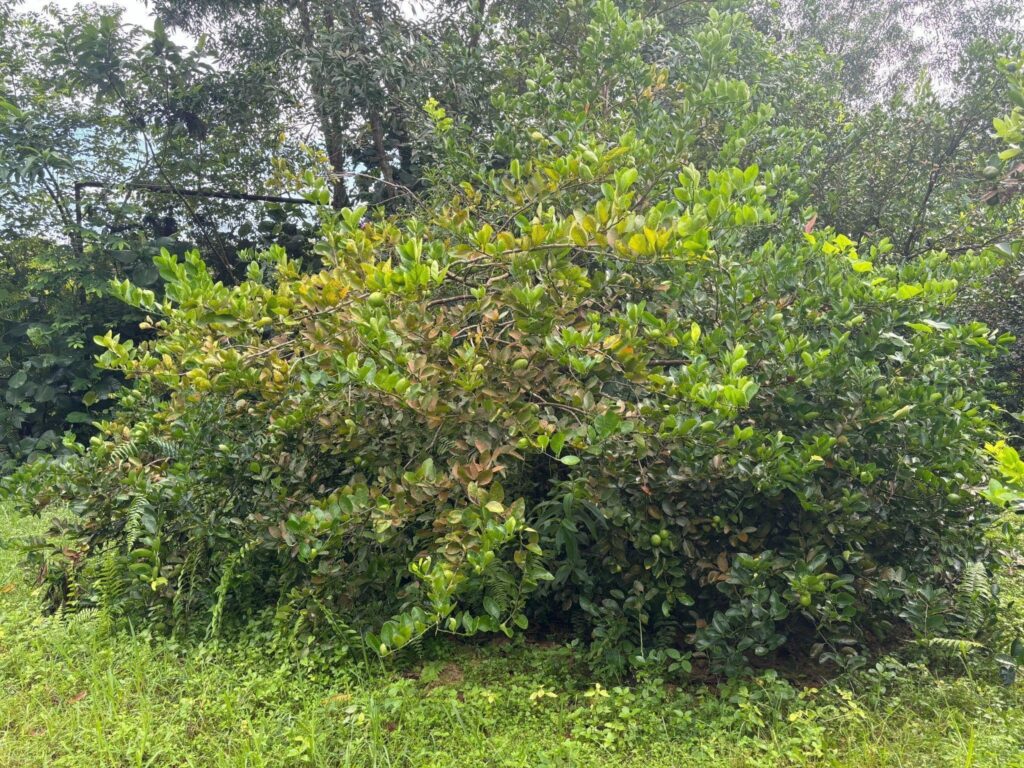
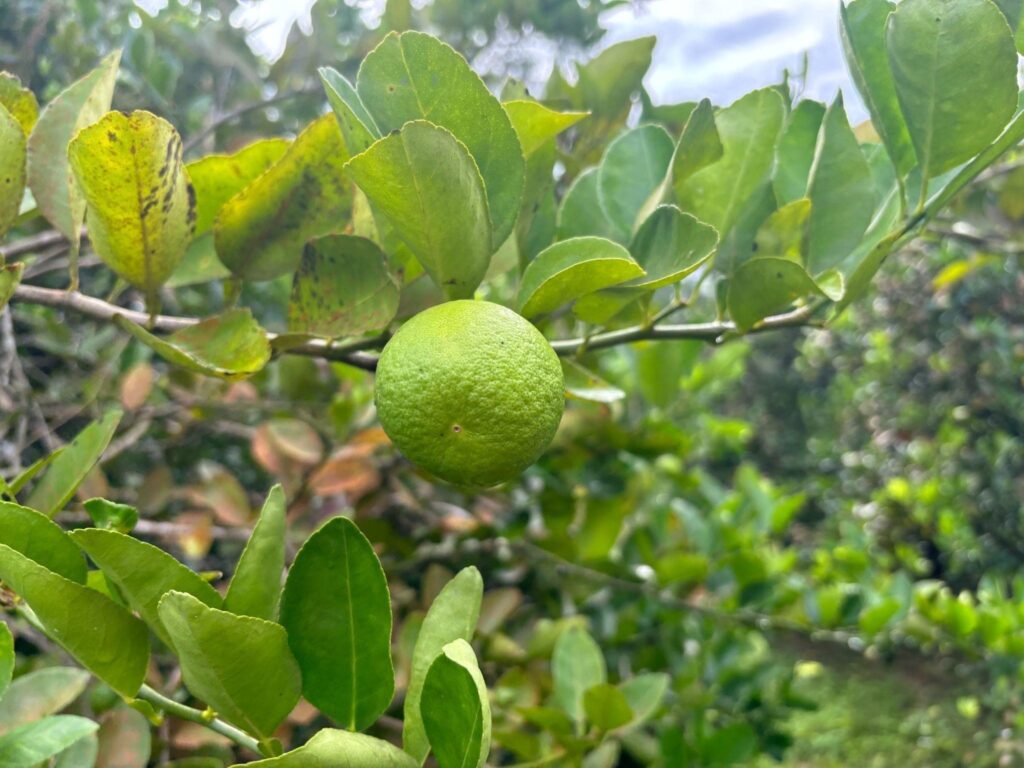
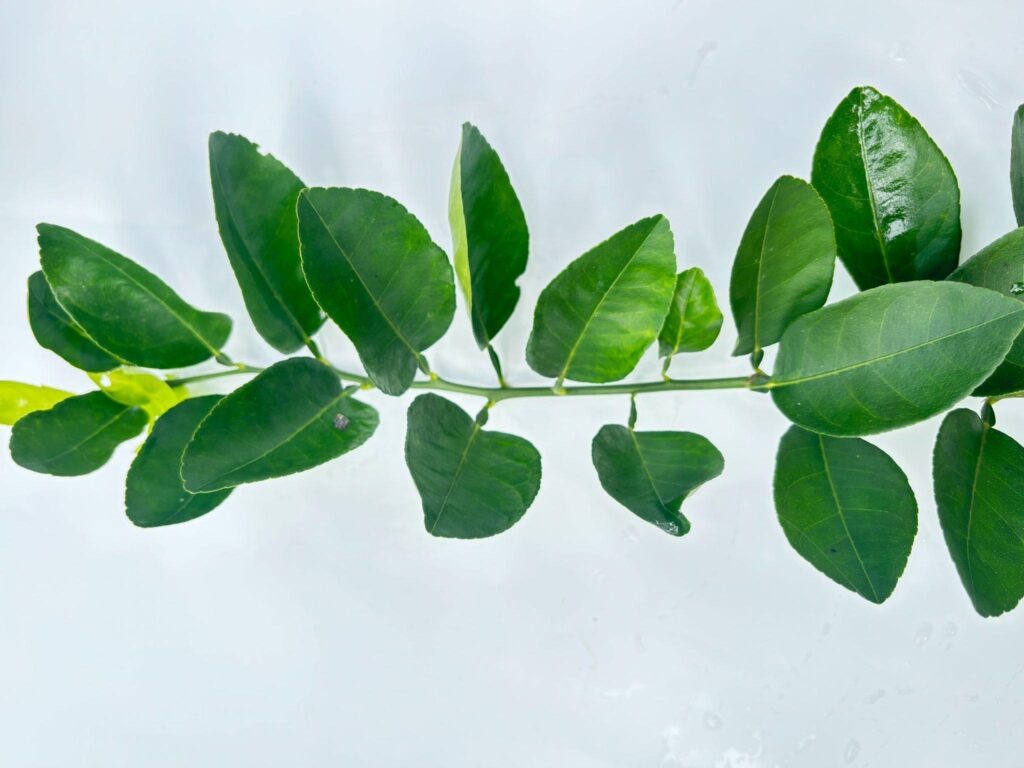
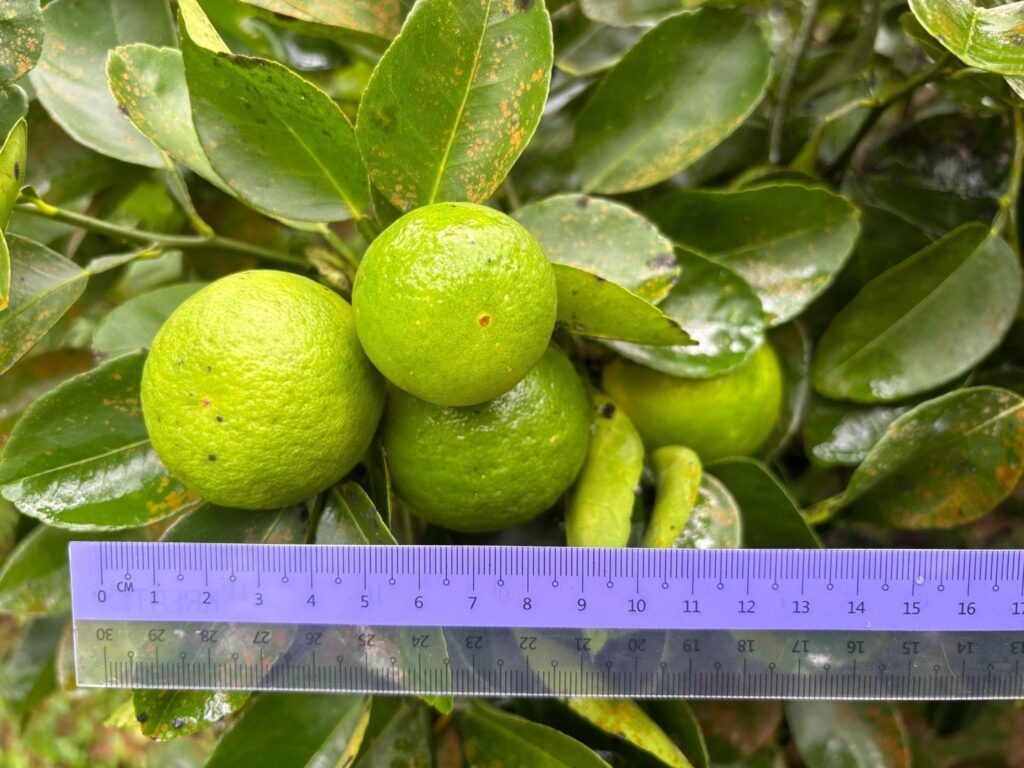
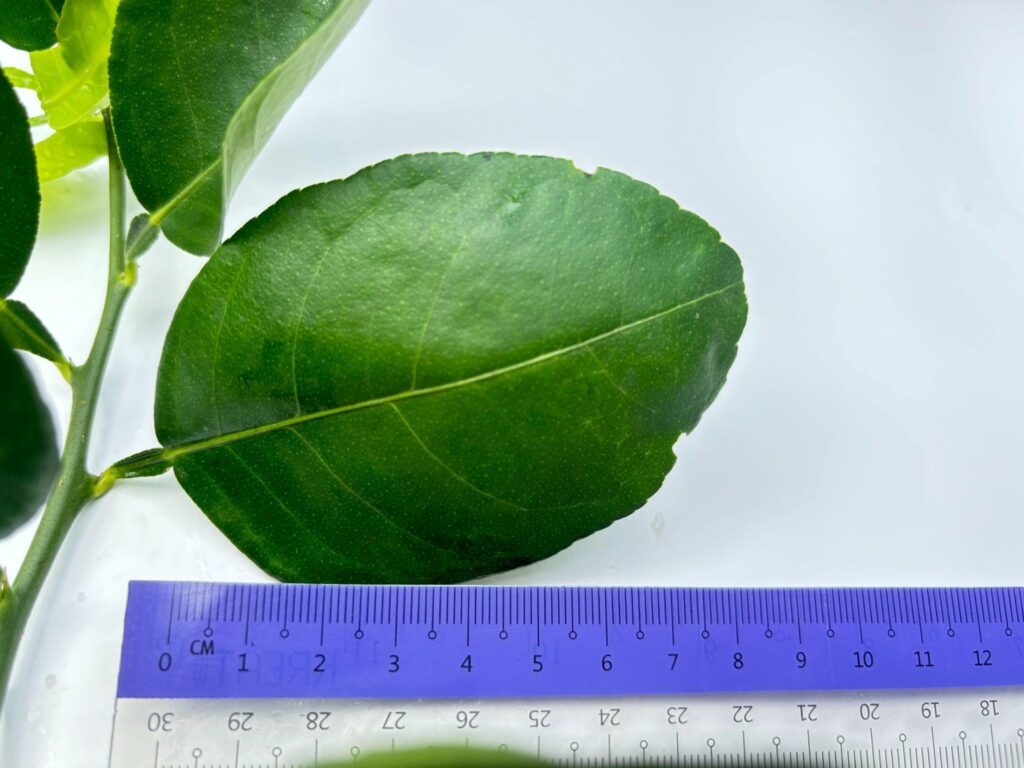
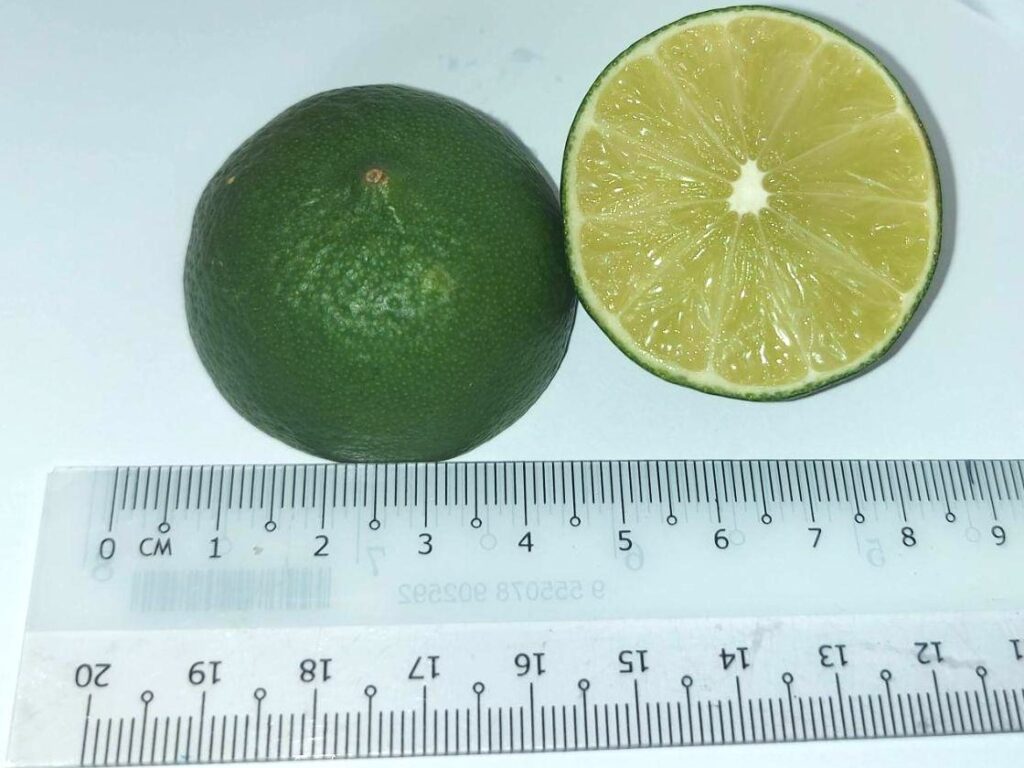
Figure 1 : Citrus aurantiifolia. (a) Whole plant; (b) bunch of fruits; (c) fruit; (d) leaf; (e) leaves with branches; (f) fruit cross-section. (Photos courtesy of UKM, 2024)
DEFINITION
Limau nipis fruit consists of the powder of dried fruits of Citrus aurantiifolia (Christm.) Swingle (Rutaceae).
SYNONYM
Limonia aurantiifolia Christm., Citrus acida Pers., Citrus amblycarpa Ochse, Citrus excelsa Wester, Citrus javanica Blume, Citrus lima Macfad., Citrus limonellus Hassk., Citrus limonellus var. amblycarpa Hassk., Citrus limonellus var. oxycarpus, Citrus longispina Wester, Citrus macrophylla Wester, Citrus medica f. aurantiifolia (Christm.) M.Hiroe, Citrus nipis Michel, Citrus notissima Blanco, Citrus ovata Hassk., Citrus papaya Hassk., Citrus pseudolimonum Wester, Citrus spinosissima G.Mey., Citrus voangasay (Bory) Bojer [1].
VERNACULAR NAMES
Common lime, Egyptian lime, Indian lime, key lime, lime, Mexican lime, sour lime, sweetie (English); limau asam, limau kapas, limau nipis (Malay); zhi qiao (Chinese); brhatjambirah, cherunaarangi, elemichcham, elumiccai, elumiccam palam, elumichai, elumichchan chaaru, elumitchanarakam, gaja nimbe, gajanimma, godnimbu, hulinimbe, ilimichai, imbe, jambira, kagadi-limbu, kaghzinimbu, kagzi nimboo, kagzi nimbu, kagzinimbu, khatta, kiccilippalam, kich chilip-pazham, leemu kaghzi, limbe, limbu, limbu chhilka, limbuphool saitrif, limpaka, madhu-karkatika, mitha-amritphal, musumbi, nagranga, narattai, nembu, nimbu, nimbukka, nimma, nima pandu, palam, sakernimbu, sertawk, soola tenga, swadunaringa, swalpa jambira, vatukappulinarakam, vijapura (India) [2, 3, 4].
CHARACTER
| Colour : | Pale-yellow powder |
| Odour : | Citrus |
| Taste : | Bitter |
IDENTIFICATION
Plant morphology
C. aurantiifolia is a small, densely and irregular branched evergreen tree, about 5 m tall without a proper crop pruning. Stems rarely grow straight, densely and irregularly branched and often originate from the lower part of the main stem,armed with short stiff sharp spines. Leaves alternate, elliptic to oblong-ovate, 4-8 x 2-5 cm, margin crenulated, and glossy-green in colour. Petioles narrowly 4-6 lobed winged. Inflorescence short axillary racemes. Flowers yellowish white in colour, calyx cup-shaped, small, fragrant, 4-6 petals of 8-12 mm long and 2.5 cm in diameter with a light trace of purple on the margins. Fruits globose to ovoid berry, 3-6 cm in diameter, sometimes with apical papillae, green when young and yellowish when they start to mature. Peel very thin and densely glandular segments with green to yellow pulp-vesicles. Seeds small, plump, ovoid, pale and smooth with white embryos (polyembryonic) [5,6,7].
Microscopy
Powdered material consists of fragments of spirally thickened vessels, fibres, epidermal cells and parenchyma cells [8].
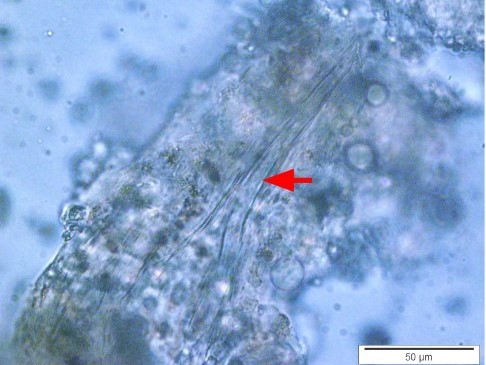
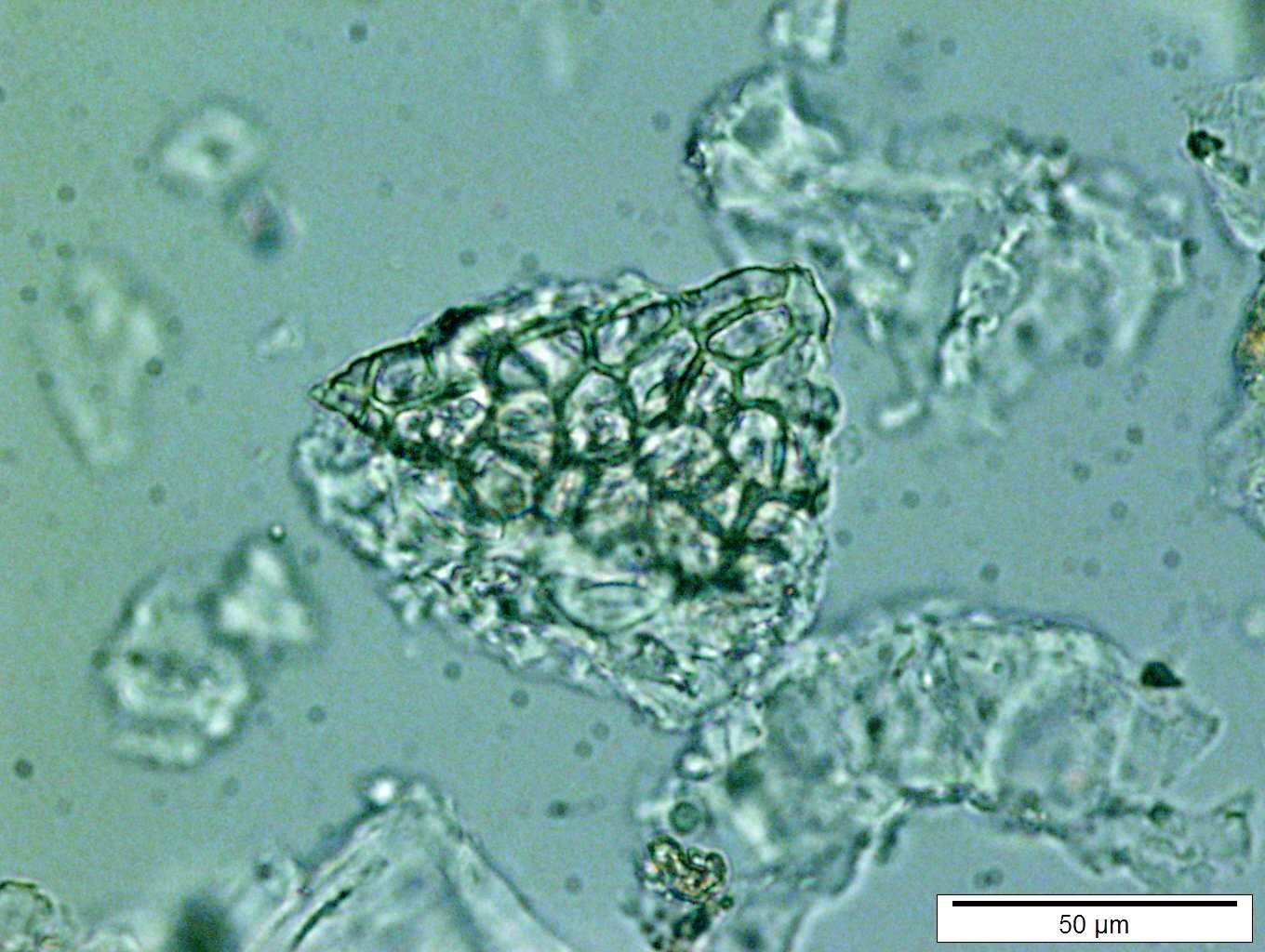
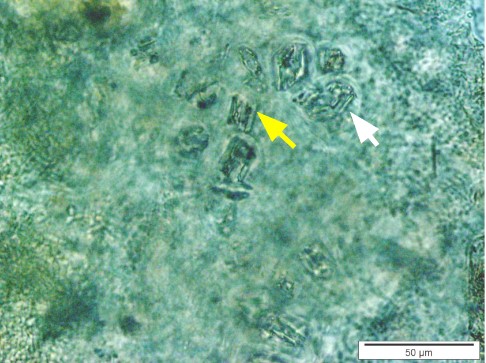
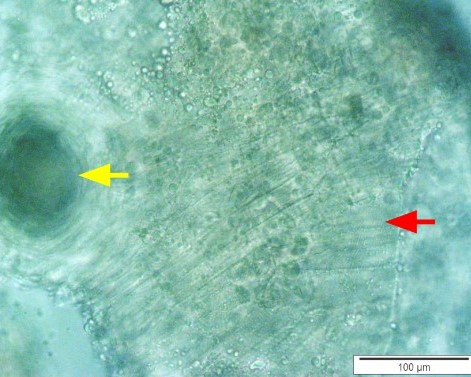
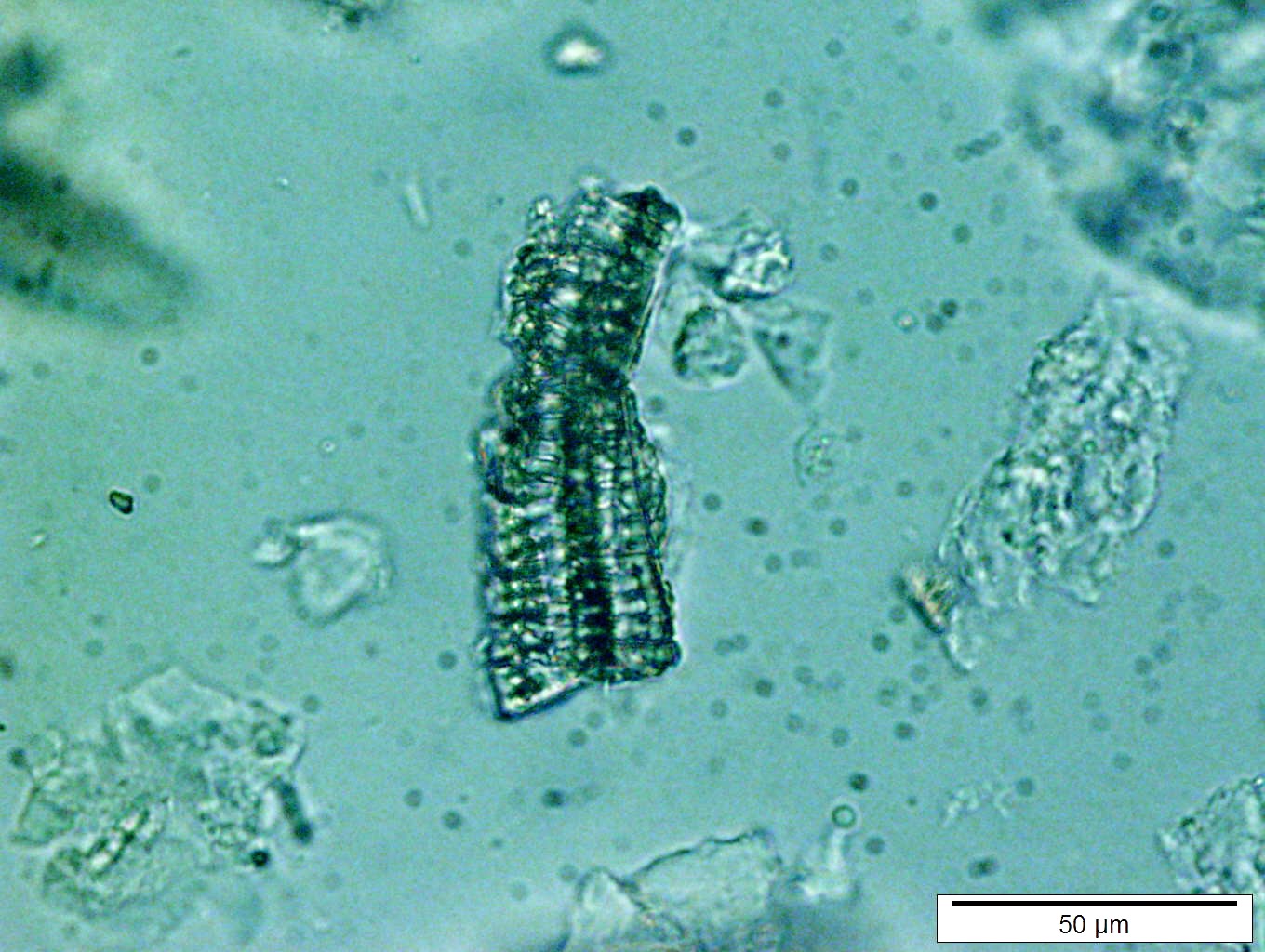

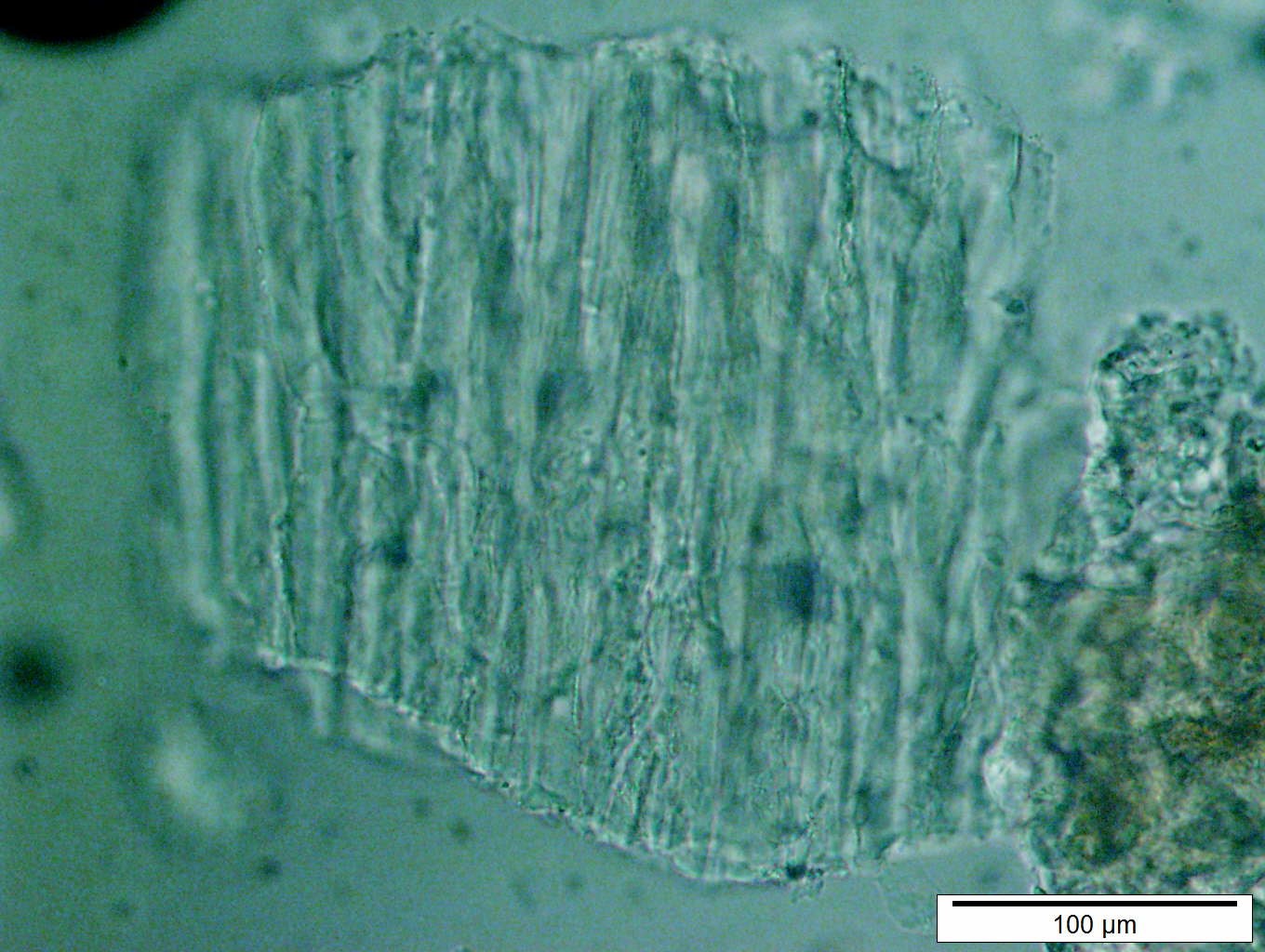

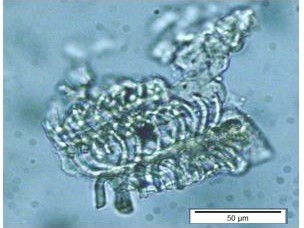
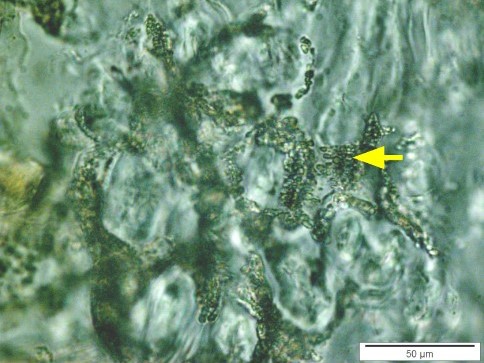
Figure 2 : Microscopic characters of Citrus aurantiifolia whole fruit powder of 0.355 mm size. (a) Vascular tissue (red arrow) (magnification 40x); (b) oil globules attached to thin-walled parenchyma cells (magnification 40x); (c) parenchyma cells (magnification 40x); (d) elongated parenchyma cells (magnification 20x); (e) solitary crystals (rhombus-yellow arrow and isodiametric-white arrow) (magnification 40x); (f) druses (yellow arrow) (magnification 40x); (g) oil gland (yellow arrow) and macrosclereids (red arrow) in elongated parenchyma cells (magnification 20x); (h) annular vessel (magnification 40x); (i) reticulate vessel (magnification 40x); (j) chloroplasts in the epidermis cells layer (yellow arrow) (magnification 40x). [Scale bars: a = 50 µm; b = 50 µm; c = 50 µm; d = 100 µm; e = 50 µm; f = 50 µm; g = 100 µm; h = 50 µm; i = 50 µm; j = 50 µm]
Chemical Tests
Observation of solution after treatment with various reagents:
| Test for the presence of alkaloids : | White precipitate |
| Test for the presence of saponin : | Presence of stable foams |
| Test for the presence of flavonoids : | Yellow to colourless |
Thin Layer Chromatography (TLC)
| Test Solution |
Weigh about 1 g of C. aurantiifolia dried whole fruit powder of 0.355 mm particle size and place it in a 50-mL conical flask. Add 20 mL of methanol to the flask and sonicate the mixture for 1 hour at 40℃. Filter the extract and repeat the extraction process twice. Evaporate the solvent using a rotary evaporator. Weigh 20 mg of the resulting dried extract and add 1 mL of methanol. Vortex the solution and place into a water bath at 40℃ until the extract is completely dissolved. Filter the solution using a 0.22 µm syringe filter. Use the filtrate as the test solution. |
| Standard solution | Dissolve 0.2 mg of hesperidin standard [CAS no.: 520-26-3] in 1 mL of methanol, and warm the mixture in a water bath maintained at 40℃ until it is completely dissolved, to produce a standard solution with a concentration of 0.2 mg/mL. |
| Stationary Phase | HPTLC Silica gel 60 F254, 10 x 10 cm |
| Mobile phase | Ethyl acetate : methanol : water; (15 : 3 : 2),(v/v/v) |
| Application |
|
| Development distance | 8 cm |
| Drying | Oven drying |
| Detection |
|
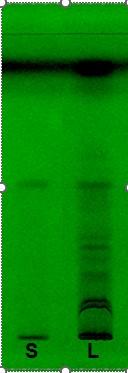
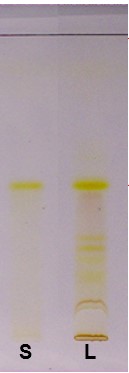
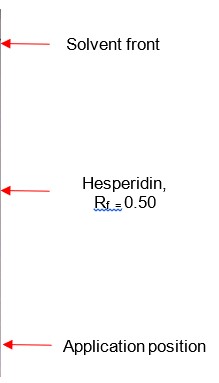
Figure 3 : HPTLC chromatogram of hesperidin (S), methanol extract of Citrus aurantiifolia dried whole fruit powder (L) observed under (a) UV at 254 nm before derivatisation and (b) visible light after derivatisation.
High Performance liquid Chromatography (HPLC)
| Test solution | Weigh about 1 g of C. aurantiifolia dried whole fruit powder of 0.355 mm particle size and place it in a 50-mL conical flask. Add 20 mL of methanol to the flask and sonicate the mixture for 1 hour at 40℃. Filter the extract and repeat the extraction process twice. Evaporate the solvent using a rotary evaporator. Weigh 100 mg of the resulting dried extract and add 1 mL of methanol. Vortex the solution and place into a water bath at 40℃ until the extract is completely dissolved. Filter the solution using a 0.22 µm syringe filter. Use the filtrate as the test solution. | |||||||||||||||||||||
| Standard solution | Dissolve 0.2 mg of hesperidin standard [CAS no: 520-26-3] in 1mL of methanol, and warm the mixture in a water bath mantained at 40℃ until it is completely dissolved, to produce a standard solution with a concentration 0.2 mg/mL. | |||||||||||||||||||||
| Chromatographic system |
Detector: Photodiode array (PDA) |
|||||||||||||||||||||
| Mobile Phase (gradient mode) |
|
|||||||||||||||||||||
| System suitability requirements |
Perform at least five replicate injections of the standard solutions (0.2 mg /mL). The requirements of the system suitability parameters are as follow:
|
|||||||||||||||||||||
| Acceptance criteria |
|


Figure 4 : Whole HPLC chromatogram of (a) hesperidin standard solution (0.2 mg/mL) at tr = 9.662 min and (b) methanol extract of C. aurantiifolia dried whole fruit powder showing a peak corresponding to hesperidin standard solution at tr = 9.603 min.
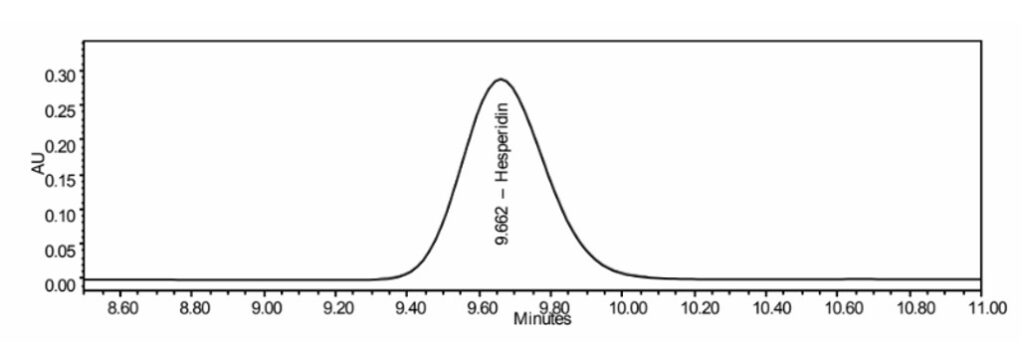
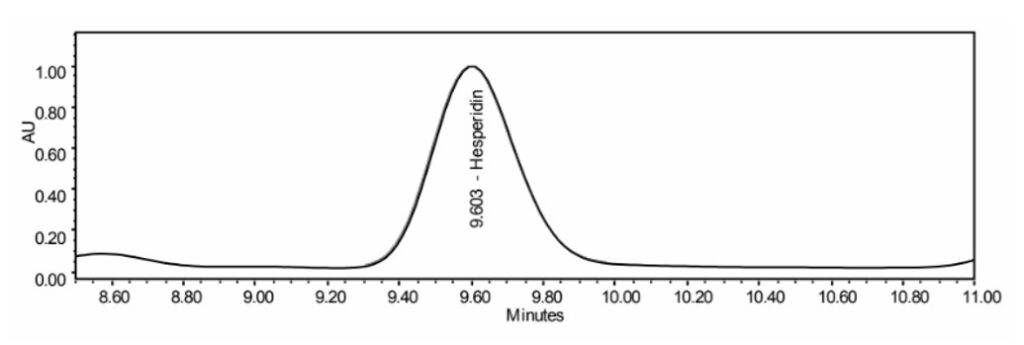
Figure 5 : HPLC chromatograms highlighting the elution region of hesperidin in (a) hesperidin standard solution (0.2 mg/mL) at tr = 9.662 min and (b) methanol extract of C. aurantiifolia dried whole fruit powder showing a peak corresponding to hesperidin standard solution at tr = 9.603 min.
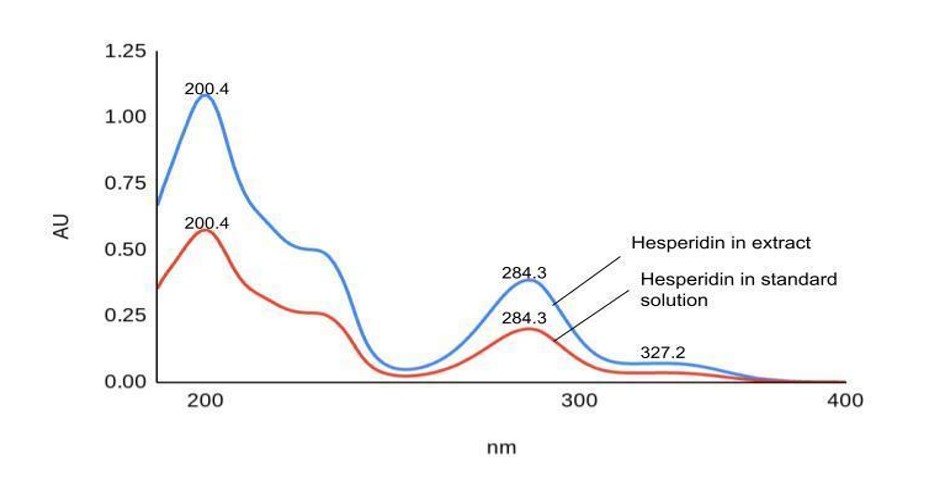
Figure 6 : UV spectra of hesperidin standard solution (0.2 mg/mL) and methanol extract of Citrus aurantiifolia dried whole fruit powder.
PURITY TEST
The purity tests except foreign matter test are based on C. aurantiifolia dried whole fruitpowder of 0.355 mm particle size.
| Foreign Matter |
| Not more than 2% |
| Ash Contents | |
| Total ash | Not more than 10% |
| Acid-insoluble ash | Not more than 2% |
| Loss on Drying |
| Not more than 14% |
| Extractive Values | |
| Water-soluble extracts | |
| Hot method | Not less than 40% |
| Cold method |
Not less than 32% |
| Ethanol-soluble extracts | |
| Hot method | Not less than 24% |
| Cold method | Not less than 12% |
SAFETY TEST
The safety tests are based on C. aurantiifolia dried whole fruit powder of 0.355 mm particle size.
CHEMICAL CONSTITUENTS
Whole Fruits
Juice of C. aurantiifolia fruits was found to contain flavonoids (e.g., eriocitrin, diosmin, heptamethoxyflavone, luteolin, hesperidin, natsudaidain, neoeriocitirin, nobiletin, tangeretin and taxifolin) [9].
Hydro-distilled essential oil of C. aurantiifolia dried whole fruits was found to contain monoterpenes (e.g., α-pinene, α-terpineol, β-pinene, γ-terpinene, cis–ocimene, fenchol, geranial, geranyl acetate, limonene, linalool, neral, neryl acetate, terpinolene and 4-terpineol), sesquiterpenes (e.g., α-bergamotene, α–bisabolol, α-cedrene, α-humulene, β-elemene, γ–elemene, δ-elemene, (E)-β-farnesene, (E)-γ-bisabolene, (Z)-β-farnesene, (Z)-β-santalene, germacrene-D, nerolidol and valencene), aldehydes (e.g., dodecanal and tetradecanal) and fatty acid (e.g., hexadecanoic acid) [10].
Hydro-distilled essential oil of C. aurantiifolia dried ripe fruits was found to contain monoterpenes (e.g., α-pinene, α–phellandrene, α–terpinene, α-terpineol, α–terpinolene, β–myrcene, β-pinene, β–terpineol, γ-terpinene, γ–terpineol, camphene, cis–ocimene, citral, citronellal, citronellyl acetate, fenchol, geraniol, geranyl acetate, neryl acetate, limonene and trans-linalool oxide), sesquiterpenes (e.g., α–bisabolol, α-copaene, α–gurjunene, β–santalene, δ-elemene, γ–elemene, (E,E)-α–farnesene, cis-α-bisabolene, germacrene-D, trans-α-bisabolene, trans-β-bergamotene, trans-β–caryophyllene and trans-β–farnesene), monoterpenoids (e.g., ρ-mentha-1,4,8-triene, ρ-mentha-3-en-1-ol and terpinene-4-ol), alkanes (e.g., eicosane, n-heptadecane, tricosane, tridecane), aldehydes (e.g., hexadecanal, myristic aldehyde, n-decanal, octadecanal, 3-cyclohexene-1-acetaldehyde), ester (e.g., butyl acetate) and fatty acids (e.g., hexadecanoic acid, 9,12-octadecadienoic acid) [11].
Hydro-distilled essential oil of C. aurantiifolia dried rotten fruits was found to contain monoterpenes (e.g., α-pinene, α–phellandrene, α–terpinene, α-terpineol, α–terpinolene, β–myrcene, β-pinene, β–terpineol, γ-terpinene, γ–terpineol, camphene, citral, citronellyl acetate, fenchol, geraniol, geranyl acetate, myrtenol, neryl acetate, limonene, linalool and trans-β-ocimene), sesquiterpenes (e.g., α–bisabolol, α–gurjunene, β–elemene, β–santalene, β-selinene, δ−cadinene, δ-elemene, γ–elemene, (E,E)-α–farnesene, aromadendrene, cis-α-bisabolene, germacrene-D, trans−α–bergamotene, trans-α-bisabolene, trans-β–caryophyllene, trans-β–farnesene and trans-γ–bisabolene), monoterpenoids (e.g., terpinene-4-ol, terpineol), alkanes (e.g., eicosane, hexadecane, n-heptadecane, nonane, tridecane), aldehydes (e.g.,hexadecanal, n-decanal, n-dodecanal, octadecanal, 3-cyclohexene-1-acetaldehyde), ester (e.g., butyl acetate) and fatty acid (e.g., hexadecanoic acid) [11].
Fruit Peels
Hydro-distillation essential oils of C. aurantiifolia fresh fruit peels was found to contain monoterpenes (e.g., α-pinene, α–phellandrene, α-terpineol, α–thujane, β-pinene, γ-terpinene, borneol, camphene, citronellal, citronellyl acetate, myrcene, neryl acetate, limonene, linalool, geraniol, geranyl acetate, p-cymene, sabinene, terpinolene, neral, geranial and (E)-β–ocimene), monoterpene ketone (e.g., camphor), sesquiterpenes (e.g., α-humulene, β–bisabolene, β–elemene, β–santalene, δ-elemene, γ-curcumene, germacrene B, germacrene D, cis-α-bergamotene, trans-α-bergamotene, (E)-caryophyllene, (E,E)-α-farnesene, (E)-α-bisabolene, (E)-β–farnesene, (Z)-α-bisabolene and (Z)-β–farnesene), monoterpenoids (e.g., bornyl acetate, citronellal, cis-sabinene hydrate, trans-sabinene hydrate and isogeranial), sesquiterpenoid (e.g., epi-α-bisabolol), aldehydes (e.g., decanal, dodecanal, exo-isocitral, nonanal, perillaldehyde and octanal), alcohols (e.g., nerol and terpinen-4-ol) and others (e.g., cis-pinocamphone) [12,13].
Hydro-distillation essential oils of C. aurantiifolia dried fruit peels was found to contain monoterpenes (e.g., α-phellandrene, α-pinene, α-terpinene, α-terpineol, ρ-cymene, β-pinene, β-phellandrene, β-myrcene, δ-3-carene, γ-cadinene, γ-terpinene, camphene, citronellal, limonene, linalool, neral, sabinene, neryl acetate, geranyl acetate, geranial, terpinolene, thujene, (E)-β-ocimene and (Z)-β-ocimene,), sesquiterpenes (e.g., α-bergamotene, α-bisabolol, α-humulene, β-bisabolene, β-caryophyllene, δ-cadinene, caryophyllene oxide, epi-bicyclosesquiphellandrene, germacrene D and (E)-β-farnesene), alcohols (e.g., nerol and n-nonalol), alkanes (e.g., eicosane, heneicosane, tricosane, pentacosane and nonacosane), monoterpenoids (e.g., α-fenchyl acetate, terpinen-4-ol, bornyl acetate and linalyl acetate), triterpenoid (e.g., manoyl oxide), aldehydes (e.g., n-decanal and tetradecanal) and tetrahydrofuran (e.g., cis-linalool oxide) [14].
Hydro-distillation essential oils of C. aurantiifolia dried fruit peels was found to contain monoterpenes (e.g., β-myrcene and R(+)-limonene), monoterpenoids (e.g., α-citral, β-linalool, geraniol, R(+)-citronellal and trans–p-mentha-1(7),8-dien-2-ol), sesquiterpenoid (e.g., β-bisabolene) and others (e.g., 2-butene ozonide) [15].
Ethanol extract of C. aurantiifolia dried fruit peels prepared by percolation was reported to contain coumarins (e.g., bergapten, isopimpinellin, imperatorin and psoralene) and flavonoids (e.g., hesperidin, myricetin and rutin) [16].
Dichloromethane extract of C. aurantiifolia fruit rinds was found to contain monoterpenes (e.g., α-pinene, α-terpinene, α-terpineol, α-thujene, β-cymene, β-myrcene, β-ocimene, β-pinene, γ-terpinene, geranial, geranyl acetate, limonene, linalool, neral, neryl acetate, tepinolene, sabinene and 1,8-cineole), sesquiterpenes (e.g., α-bergamotene, α-bisabolene, α-farnesene, β-bisabolene, β-caryophyllene, β-elemene, δ-elemene, γ-elemene, germacrene B and germacrene D), coumarins (e.g., bergaptene, isobergaptene, isopimpinellin, 5,7-dimethoxycoumarin and 7-methoxycoumarin) and aldehyde (e.g., decanal) [17].
Hexane extract of C. aurantiifolia fruit peels was reported to contain monoterpenes (e.g., α-terpineol, ρ-cymene, carvone, citral, geraniol, geranyl acetone and 3,7-dimethyl-(Z)-2,6-octadienal), sesquiterpenes (e.g., bergamotene, caryophyllene oxide, spathulenol and trans-α-bisabolene), monoterpenoid (e.g., terpinen-4-ol) coumarins (e.g., umbelliferone, 5-methoxypsoralen, 5,7-dimethoxycoumarin and 5,8-dimethoxypsoralen), fatty acids (e.g., methyl palmitate, linoleic acid, oleic acid, palmitic acid, (Z)-8-methyl-9-tetradecenoic acid, 3-hexen-2-one and 4-hexen-3-one), alkanes (e.g., nonacosane, octacosane and pentacosane), alkenes (e.g., tricosane and 1-methoxycyclohexene), ketones (e.g.,versalide, 3-methyl-1,2-cyclopentanedione and 3-methyl-3-penten-2-one), alcohols (e.g.,pinacol and resorcinol), esters (e.g., geranyl formate and (11Z)-12-(2-oxiranyl)-11-dodecenyl acetate), heterocyclic ether (e.g., linalool oxide), fatty alcohols (e.g., tetracosanal and 1-heptatriacontanol), isoprenoid (e.g., trans-phytol), carboxylic acid (e.g., crysantenile acetate) and others (e.g., 7-methyl-(Z)-8-tetradecen-1-ol acetate, corylone, 1,8-dimethyl-4-(1-methylethyl)- spiro[4.5]dec-8-en-7-one, tetrahydro-2–methyl-2H-pyran) [18].
Cold pressed essential oil of C. aurantiifolia fruit peels was found to contain monoterpenes (e.g., α-fenchene, α-phellandrene, α-terpineol, α-terpinene, α-thujene, α-pinene, β-pinene, δ-3-carene, γ-terpinene, γ-terpineol, ρ-cymene, (E)-β-ocimene, (Z)-β-ocimene, borneol, camphene, carvone, citronellol, cis-β-terpineol, geranial, geraniol, geranyl acetate, limonene, linalool, myrcene, myrcenol, neral, neryl acetate, isoborneol, piperitone, sabinene, trans-β-terpineol, trans-carveol, terpinolene, tricyclene, 1,4-cineole and 1,8-cineole), sesquiterpenes (e.g., α-bisabolol, α-cadinol (t), α-humulene, α-muurolene, α-selinene, β-bisabolene, β-caryophyllene, β-elemene, β-santalene, β-selinene, δ-cadinene, δ-elemene, δ-selinene, γ-eudesmol, cis-α-bergamotene, epi-α-selinene, germacrene B, selina-4,11-diene, trans-α-bergamotene, (E,E)-α-farnesene, (E)-γ-bisabolene, (E)-nerolidol, (Z)-α-bisabolene, (Z)-β-farnesene and (Z)-γ-bisabolene), alcohols (α-fenchol, ρ-cymen-8-ol, (E)-ocimenol, (Z)-ocimenol, campherenol, caryophyllene alcohol, cis-ρ-menth-2-en-1-ol, decanol, dodecanol, epi-α-cadinol (t), epi-α-muurolol (t), nonanol, trans-ρ-menth-2-en-1-ol, terpinen-1-ol, terpinen-4-ol, selin-7(11)-en-4-ol, octanol and undecanol), aldehydes (e.g., decanal, dodecanal, nonanal, octanal, perilla aldehyde, tetradecanal and undecanal), alkanes (e.g., nonane and undecane), fatty acid (e.g., decanoic acid), ketone (e.g., ρ-methyl-acetophenone), alkane (e.g., bornylene), monoterpenoids (e.g., cis-linalool oxide, trans-linalool oxide and sabinyl acetate), sesquiterpenoid (e.g., selina-3,7(11)-diene), pyran (e.g., 2,3-dehydro-1,8-cineole) and oxane (e.g., 2,6,6-trimethyl-2-vinyl-tetrahydropyran) [19].
Edible oil of C. aurantiifolia fruit peel was found to contain monoterpenes (e.g., α-phellandrene, α-pinene, α-terpinene, α-terpineol, β-pinene, γ-terpinen, γ-terpineol, ρ-cymene, (E)-β-ocimene, (Z)-β-ocimene, borneol, camphene, cis-β-terpineol, endo-fenchol, geraniol, geranyl acetate, limonene, linalool, m-cymenene, myrcene, neryl acetate, terpinolene, terpinen-4-ol, trans-carveol, selina-3,7(11)-diene, 1-terpineol and 1,4-cineole), sesquiterpenes (e.g., α-bisabolol, α-cadinol, α-humulene, α-selinene, β-bisabolene, β-elemene, β-selinene, δ-cadinene, δ-elemene, γ-elemene, γ-selinene, (E)-caryophyllene, (E)-β-farnesene, (E)-γ-bisabolene, (Z)-α-bisabolene, (Z)-γ-bisabolene, caryophyllene oxide, germacrene B, germacrene D and trans-α-bergamotene), alcohols (e.g., isopentyl alcohol and n-decanol) and alkane (e.g., n-nonane) [20].
Seed
Methanolic (80%) fraction of C. aurantiifolia dried seeds was found to contain tetracyclic triterpenoid (e.g., limonin glucoside) [21].
Ethyl acetate fraction of C. aurantiifolia dried seeds was found to contain tetracyclic triterpenoids/limonoids (e.g., limonin, limonexic acid and isolimonexic acid) and phytosterol (e.g., β-sitosterol glucoside) [21].
Seed oil from petroleum ether extract of C. aurantiifolia dried seeds was reported to contain fatty acids (e.g., arachidic acid, linoleic acid, linolenic acid, oleic acid, palmitic acid, stearic acid and vaccenic acid), tocopherols (e.g., α-tocopherol, γ-tocopherol, γ-tocotrienol and plastochromanol-8) and phytosterols (e.g., β-sitosterol, δ-5-avenasterol, δ-7-avenastenol, δ-7-campesterol, δ-7-stigmasterol, campestanol, chlerosterol, cholesterol, sitostanol, stigmasterol, 5,24-stigmastadienol and 24-methylene cholesterol) [22].
MEDICINAL USES
Uses described in folk medicine, not supported by experimental or clinical data
Traditionally used for treatment of irregular menstrual flow, as well as remedies for various ailments, including for cardiotonic, laxative, anthelmintic, tonic, aphrodisiac, febrifuge, headache, fevers, diarrhea, dysentery and emetic. It is also used for cough and sore throats. [3,4].
The juice is used to get rid of fungal infections by slicing into pieces and dipping into sulfur before rubbing onto the skin. Salted fruits are mashed in water and used as a remedy for coughs and sore throats. The fresh juice is taken daily as a remedy for high blood pressure. The juice is also used as a native antidote for dart poison by squeezing the juice onto the wound [23,24].
Biological and pharmacological activities supported by experimental data
Antioxidant activity
Essential oils of C. aurantiifolia fresh peel showed high radical scavenging activity (IC50 value of 19.6±1.1 Trolox equivalent antioxidant capacity (TEAC) value) compared to ascorbic acid (IC50 value of 0.96±0.03 TEAC value) using antioxidant capacity determined by radical cation, ABTS assay [14].
Methanol crude extract of C. aurantiifolia dried peel showed antioxidant properties displayed by IC50 values obtained in 2,2-diphenyl-1-picrylhydrazyl (DPPH) assay (78.3±1.8 µg/mL), ABTS assay (18.7±1.1 TEAC value) and ferric reducing antioxidant power (FRAP) assay (112.1±2.2 µmol/L Fe(II) g) compared to ascorbic acid (5.0±0.8 µg/mL and 0.96±0.03 TEAC value, respectively) and BHT (63.2±4.5 µmol/L Fe(II) g) [25].
Chloroform extract of C. aurantiifolia driedpeel showed free radical scavenging activity (IC50 value = 153.68±3.60 µg/mL) compared to ascorbic acid (IC50 value = 18.16±1.79 µg/mL) in DPPH radical scavenging assay [26].
The isolated fraction from n-hexane (P3) extract of C. aurantiifolia dried peel significantly (p < 0.01) showed moderate antioxidant ability after 30 mins and 60 mins (IC50 value = 9.7±0.7 and 18.5±1.1 µg/mL, respectively)compared to propyl gallate (IC50 value = 1.0±0.04 and 1.0±0.03 µg/mL, respectively) using β-carotene bleaching test [25].
Anti-inflammatory activity
Ethanolic (96%) extract of C. aurantifolia fresh peel (750 mg/kg body weight per single dose) administered orally to Salmonella typhi induced BALB/c mice after 5 days of injection (30 – 40 g weight, and age of 8 – 12 weeks) for 30 days, decreased the level of Interleukin 6, IL-6 based on the differences mean value of IL-6 at pre-prevention, post-prevention and 30th day after intervention (2452±771 to 11561±5692 rg/mL) compared to levofloxacin (2407±706 to 27341±6826 rg/mL) using IL6 ELISA Mouse Sandwich method [27].
Antimicrobial activity
Filtered juice of C. aurantiifolia fresh fruit (100%) inhibited the growth of Trichophyton rubrum (24 mm) compared to 100 mg/mL of fluconazole (18 mm) using well diffusion method [28].
Essential oil of C. aurantiifolia fresh peel displayed promising activity based on MIC value against Streptococcus mutans (20 µg/mL) and Lactobacillus casei (31.25 µg/mL) compared to chlorhexidine dihydrochloride (0.922 and 1.844 µg/mL, respectively) using broth microdilution method [29].
Essential oil of C. aurantiifolia fresh peel (512 mg/mL) displayed high antimicrobial activity against Staphylococcus aureus ATCC 25921, S. aureus, Enterococcus faecalis, Escheria coli ATCC 25922, E. coli, Shigella flexneri, Salmonella paratyphi, Porphyromonas spp., Clostridium spp. and Bacteroides spp. (30, 40, 25, 30, 25, 30, 40, 27, 31 and 30 mm, respectively) compared to ciprofloxacin (20, 20, 16, 27, 27, 33, 30, 26, 27 and 24 mm, respectively) in Mueller-Hinton agar [30].
Aqueous extract of C. aurantiifolia dried whole fruit (512 mg/mL) displayed strong antimicrobial activity against S. aureus ATCC 25921, S. aureus, E. faecalis and Citrobacter spp. (22, 33, 24 and 22 mm, respectively) with MIC values ranging from 128 – 256 mg/mL, compared to ciprofloxacin (22, 33, 24 and 22 mm, respectively) by using Mueller-Hinton agar [30].
Ethanol (75%) extract of C. aurantiifolia dried whole fruit (512 mg/mL) showed high antimicrobial activity against S. aureus ATCC 25921, S. aureus, E. faecalis, Serratia spp. and Pseudomonas aeruginosa (22, 35, 20, 24 and 20 mm, respectively) with MIC values ranging from 64 – 256 mg/mL compared to ciprofloxacin (20, 20, 16, 25 and 17 mm, respectively) in Mueller-Hinton agar [30].
Ethanol (90%) crude extract of C. aurantiifolia dried peel (50 mg/mL) significantly (p < 0.001) inhibited the growth of S. aureus, Staphylococcus epidermidis, Listeria monocytogenes, Haemophilus influenzae and Corynebacterium sp. (34.56±2.65, 31.67±8.33, 34.33±2.08, 30.13±1.82 and 31.67±2.52 mm, respectively) compared to vancomycin (16.41±2.65, 19.35±20.0, 17.33±2.31, 18.13±2.36 and 17.21±20.0 mm, respectively) using well-diffusion method [31].
Ethanol (96%) extract of C. aurantiifolia fresh peel (750 mg/kg body weight per single dose) administered orally to Salmonella typhi induced BALB/c mice after 5 days of injection (30 – 40 g body weight range age of 8 – 12 weeks) for 30 days had significant (p=0.001) inhibited bacterial colony count from 17.2×103 CFU/mL to no growth on the 10th day compared to levofloxacin (98 mg/kgbw; 30.4×103 to 1.6×103 CFU/mL) on 30th day using plate count agar method [27].
Ethanol crude extract of C. aurantiifolia dried peels (1.0 g/mL) significantly (p<0.05) inhibited the growth of S. aureus based on inhibitory zone (19 mm) compared to ciprofloxacin (22 mm) in nutrient agar [32].
Chloroform crude extract of C. aurantiifolia driedpeel (300 µg/disc) showed moderate activity based on zone of inhibition against Bacillus cereus (19 mm) compared to kanamycin (30 µg/disc; 30mm) using disc diffusion technique [26].
Chloroform crude extract of C. aurantiifolia dried peel (300 µg/disc) showed strong activity based on zone of inhibition against Salmonella paratyphi, S. typhi, Vibrio mimicus, Shigella dysenteriae and P. aeruginosa (15, 13, 13, 15 and 17 mm, respectively) compared to kanamycin (30 µg/disc; 17, 17, 13, 24 and 28 mm, respectively) using disc diffusion technique [26].
Compounds (4-hexen-3-one, citral, geraniol) isolated from hexane extract of C. aurantiifolia fresh peel (10 mg/mL) showed anti-giardial effect against Giardia lamblia with IC50 of 34.2, 64.5 and 229.49 µg/mL, respectively compared to metronidazole (IC50 = 0.52 µg/mL) using TYI-S-33 medium in growth inhibition assay [33].
Compounds (5,8-dimethoxypsoralen and palmitic acid) isolated from hexane extract of C. aurantiifolia fresh peel showed anti-mycobacterial against Mycobacterium tuberculosis H37Rv (MIC value of 25 µg/mL for both compounds) and 3 multidrug-resistant M. tuberculosis; H10 (MIC value of 25 and 50 µg/mL, respectively), M15 (MIC value = >50 and 50 µg/mL, respectively) and M26(MIC value of 50 µg/mL for both compounds) compared to isoniazid (MIC values of 0.02, 5, 7 and 6 µg/mL, respectively to strains) and rifampicin (MIC values of 0.08, 9, 10 and 12 µg/mL, respectively to strains) using microplate Alamar Blue assay [18].
Anticancer activity
Methanol extract of C. aurantiifolia freeze-dried juice inhibited the growth of Panc-28 cancer cells (100 µg/mL; 74.28±1.02% at 96 hours) with IC50 value of 81.20 µg/mL after 72 hours compared to tamoxifen acetate (50 µg/mL; 93.70±1.28% at 96 hours) using cell count assay [34].
Anticholinesterase activity
Essential oils of C. aurantiifolia fresh peel inhibited selectively to neurotransmitter acetylcholine, AChE with IC50 value of 139.3±2.4 µg/mL compared to physostigmine with IC50 value of 0.2±0.02 µg/mL using AChE inhibition assay (Electrophorus electricus 3.1.1.7, Type VI-S) based on reaction of released thiocholine to produce coloured product with chromogenic reagent [14].
Antispasmodic activity
Essential oil of C. aurantiifolia fresh peel at a concentration of 8 μg/mL showed an amplitude inhibition of 68±3.0% on isolated rabbit jejunum compared to nifedipine (1 μg/mL; 89.0±4.2 %). For frequency inhibition, the essential oil resulted in a decrease of 47±2.8% in the rate of spontaneous contractions compared to nifedipine (1 μg/mL; 77.8±4.1%) [12].
Cytotoxicity activity
Essential oils of C. aurantiifolia blended whole fruit showed 78% inhibition of human colon cancer cells, SW-480 with 100 µg/mL concentration at 48 hours compared to camptothecin (25 µg/mL; 64%) using MTT assay [35].
Antiparasitic activity
Filtered juice of C. aurantiifolia fresh fruit (0.5 and 1.0 mg/mL) significantly (p < 0.05) showed ovicidal activity of Heligmosomoides bakeri with IC50 = 0.43 mg/mL compared to albendazole with IC50 = 0.39 mg/mL using agar plate method [36].
Filtered juice of C. aurantiifolia fresh fruits (800 mg/kg body weight per single dose) administered orally to healthy albino mice (Mus musculus) of both sexes within the ages of 10 to 12 weeks on 16th day post-infection with H. bakeri significantly (p < 0.01) showed larvicidal activity (80.5%) compared to albendazole (10 mg/kg; 94.4%) [37].
Clinical studies
A treatment trial involving 74 post-operative urolithiasis patients with no stone residues after one month removal surgery (36 in treatment group; 38 in placebo group) was conducted to study short term anti-lithogenic properties of in-house manufactured lime powder regimen (LPR) containing 63 and 21 mEq of citrate and potassium, daily for 6 months. In the LPR treatment group, urinary excretion of calcium (57.67 mg/day) and oxalate (20.28 mg/day) decreased after 6 months compared to initial treatment (84.14 and 27.56 mg/day, respectively), meanwhile no significant changes were observed in the placebo group. Elevation in urinary citrate and potassium was observed only in LPR, meanwhile other parameters remained unchanged. Based on Tiselius and Ogawa index calculated from urinary excretion rate of oxalate, citrate and magnesium significantly differs after 6 months in LPR group (p = 0.124 in Tiselius Index; p = 0.081 in Ogawa Index) compared to placebo group (p = 0.523 in Tiselius Index; p = 0.625 in Ogawa Index) [38].
SAFETY INFORMATION
Preclinical studies (Toxicology studies)
Safety assessment
Essential oil of C. aurantiifolia fresh fruit peel (10 mg/mL) administered directly onto chorioallantoic membrane to fertilised chicken egg (day 10 with controlled temperature and humidity; 37.5±0.5 ℃ and 60-70%, respectively) for 5 minutes showed no irritation potential. Irritation score (IS) value obtained (10.410±0.147) compared to 0.1M NaOH-control (13.44±0.13) [15].
Others (Adverse reactions, contraindications, side effects, warning, precautions)
Information and data have not been established.
DOSAGE
Information and data have not been established.
STORAGE
Store below 30°C. Protect from light and moisture.
REFERENCES
- The World Flora Online Plant List. [Internet] Citrus aurantiifolia (Christm.) Swingle; 2023 [cited on 26 Mac 2024]. Available from: https://wfoplantlist.org/taxon/wfo-0001242548-2023-12?page=1
- Global Information Hub On Integrated Medicine. [Internet] Citrus aurantifolia Shahrul; 2022 [cited on 26 Mac 2024]. Available from: https://globinmed.com/conservation/limau-nipis/#1
- Burkill, I. H. A Dictionary of The Economic Products of The Malay Peninsula. Vol I A-H. London:Crown Agents for The Colonies. 1935; Vol.1 563-566.
- Quattrocchi Umberto. CRC World Dictionary of Medicinal and Poisonous Plants: Common Names, Scientific Names, Eponyms, Synonyms and Etymology. Vol II C-D. Florida: CRC Press. 2012; Vol. II 280-281.
- Global Information Hub On Integrated Medicine. [Internet] Citrus aurantifolia (Christm. & Panzer) Shahrul; 2021 [cited on 26 Mac 2024]. Available from: https://globinmed.com/conservation/citrus-aurantifolia-christm-a-panzer/
- Panduan penanaman limau nipis. Kuala Lumpur: Jabatan Pertanian Semenanjung Malaysia. 2010.
- Khan IA, Abourashed EA. Leung’s Encyclopedia of Common Natural Ingredients. New Jersey: John Wiley and Sons Publication. 2010:422-423.
- MHM 2015 book [Online]
- Kawaii S, Tomono Y, Katase E, Ogawa K, Yano M. Antiproliferative effects of the readily extractable fractions prepared from various citces on several cancer cell lines. Journal of agricultural and food chemistry. 1999;47(7):2509-12.
- Yadav AR, Chauhan AS, Rekha MN, Rao LJ, Ramteke RS. Flavor quality of dehydrated lime [Citrus aurantifolia (Christm.) Swingle]. Food Chemistry. 2004;85(1):59-62.
- Afolayan AJ, Asekun OT. Comparative Study of the Chemical Profiles of the Essential Oils of Ripe and Rotten Fruits of Citrus aurantifolia Swingle. Natural Product Communications. 2008;3(7).
- Spadaro F, Costa R, Circosta C, Occhiuto F. Volatile composition and biological activity of key lime Citrus aurantifolia essential oil. Natural Product Communications. 2012;7(11).
- Costa R, Bisignano C, Filocamo A, Grasso E, Occhiuto F, Spadaro F. Antimicrobial activity and chemical composition of Citrus aurantifolia (Christm.) Swingle essential oil from Italian organic crops. Journal of Essential Oil Research. 2014;26(6):400-8
- Tundis R, Loizzo MR, Bonesi M, et al. Comparative study on the antioxidant capacity and cholinesterase inhibitory activity of Citrus aurantifolia Swingle, C. aurantium L., and Citrus bergamia Risso and Poit. peel essential oils. J Food Sci. 2012;71(1):H40-46.
- Weimer P, Moura JG, Mossmann V, Immig ML, de Castilhos J, Rossi RC. Citrus aurantiifolia (Christm) Swingle: Biological potential and safety profile of essential oils from leaves and fruit peels. Food Bioscience. 2021;40:100905.
- Shalaby NM, Abd-Alla HI, Ahmed HH, Basoudan N. Protective effect of Citrus sinensis and Citrus aurantifolia against osteoporosis and their phytochemical constituents. J Med Plants Res. 2011;5(4):579-88.
- Craske JD, Suryadi N, Wootton M. A comparison of the peel oil components of Australian native lime (Microcitrus australe) and Mexican lime (Citrus aurantifolia Swingle). Journal of the Science of Food and Agriculture. 2005;85(3):522-5.
- Sandoval-Montemayor NE, García A, Elizondo-Treviño E, Garza-González E, Alvarez L, del Rayo Camacho-Corona M. Chemical composition of hexane extract of Citrus aurantifolia and anti-Mycobacterium tuberculosis activity of some of its constituents. Molecules. 2012;17(9):11173-84.
- Chamblee, TS., & Clark, BC. (1997). Analysis and Chemistry of Distilled Lime Oil (Citrus aurantifolia Swingle). Journal of Essential Oil Research. 9(3), 267–274.
- Jafari S, Esfahani S, Fazeli MR, Jamalifar H, Samadi M, Samadi N, Toosi AN, MR, Ardekani S, Khanavi M. Antimicrobial Activity of Lime Essential Oil Against Food-borne Pathogens Isolated from Cream-filled Cakes and Pastries. International Journal of Biological Chemistry. 2011;5: 258-265.
- Patil JR, Jayaprakasha GK, Murthy KC, Chetti MB, Patil BS. Characterization of Citrus aurantifolia bioactive compounds and their inhibition of human pancreatic cancer cells through apoptosis. Microchemical Journal. 2010;94(2):108-17.
- Matthaus B, Özcan MM. Chemical evaluation of citrus seeds, an agro-industrial waste, as a new potential source of vegetable oils. grasas y aceites. 2012;63(3):313-20.
- Ong, H. C. (1994). The Ethnobotany of Citrus and Their Relatives. Korean Journal of Plant Taxonomy, 24(3), 157-171.
- Gimlette, John D. Malay poisons and charm cures London: J. & A. Churchill. 1923;2nd edition. 181.
- Loizzo MR, Tundis R, Bonesi M, Menichini F, De Luca D, Colica C, Menichini F. Evaluation of Citrus aurantifolia peel and leaves extracts for their chemical composition, antioxidant and anticholinesterase activities. J Sci Food Agric. 2012;92:2960-2967.
- Ghosh R, Hoque N, Shanta MA, Nasrin N, Asaduzzaman M. Antioxidant, antimicrobial and cytotoxic activities of different fractions of Citrus aurantifolia peel. Dhaka University Journal of Pharmaceutical Sciences. 2020;19(2):161-8.
- Kasim VN, Hatta M, Natzir R, Hadju V, Hala Y, Alam G, As’ad S, Febriza A, Idrus HH. Antibacterial and anti-inflammatory effects of lime (Citrus aurantifolia) peel extract in Balb/c mice infected by Salmonella typhi. Journal of Biological Research. 2020.
- Ugwu CC, Mbah-Omeje KN, Ezeugwu RI, Onuorah SC, Agbo MC. Antimicrobial activities and phytochemical screening of Citrus aurantifolia (Lime) leaf extracts and fruit juice on some microorganisms. International Journal of Innovative Research and Development. 2018;7(3):135-42.
- Lemes RS, Alves CC, Estevam EB, Santiago MB, Martins CH, SANTOS TC, Crotti AE, Miranda ML. Chemical composition and antibacterial activity of essential oils from Citrus aurantifolia leaves and fruit peel against oral pathogenic bacteria. Anais da Academia Brasileira de Ciências. 2018; 90:1285-92.
- Aibinu I, Adenipekun T, Adelowotan T, Ogunsanya T, Odugbemi T. Evaluation of the antimicrobial properties of different parts of Citrus aurantifolia (lime fruit) as used locally. African Journal of Traditional, Complementary, and Alternative Medicines. 2007;4(2):185.
- Salih ND. Evaluation of the antimicrobial effects of Citrus aurantifolia (key lime) against different microbial species isolated from asthma and sinusitis patients. World J. Pharm. Pharm. Sci. 2015;4(5):324.
- Ekawati ER, Pradana MS, Darmanto W. Lime (Citrus aurantifolia) peel as natural antibacterial for wound skin infection caused by Staphylococcus aureus. International Journal of Pharmaceutical Research. 2019;11(1):363-6.
- Domínguez-Vigil IG, Camacho-Corona MD, Heredia-Rojas JA, Vargas-Villarreal J, Rodríguez-De la Fuente AO, Heredia-Rodríguez O, Mata-Cardenas BD. Anti-giardia activity of hexane extract of Citrus aurantifolia (Christim) Swingle and some of its constituents. African Journal of Traditional, Complementary and Alternative Medicines. 2015;12(2):55-9.
- Patil, J. R., Murthy, K. N. C., Chetti M. B., Patil, B. S. Bioactive Compounds from Mexican Lime (Citrus aurantifolia) Juice Induce Apoptosis in Human Pancreatic Cells. Journal of Agricultural and Food Chemistry. 2009;57(22): 10933-10942.
- Patil, J. R., Jayaprakasha, G. K., Murthy, K. N. C., Tichy, S. E., Patil, B. S. Apoptosis-mediated proliferation inhibition of human colon cancer cells by volatile principles of Citrus aurantifolia. Food Chemistry. 2009;114: 1351-1358.
- Enejoh S, Suleiman M, Ajanusi J, Ambali S. In vitro anthelmintic efficacy of extracts of Citrus aurantifolia (Christm) Swingle fruit peels against Heligmosomoides bakeri ova and larvae. Int J Curr Pharm Res. 2015;7:92–6.
- Enejoh S, Shuaibu K, Suleiman M, Ajanusi J. Evaluation of anthelmintic efficacy of extracts of Citrus aurantifolia fruit juice in mice experimentally infected with Heligmosomoides bakeri. Int J Biol Res.2014;4:241–6.
- Ungjaroenwathan, W., Chiramongkolsiri, T., Dissayabutra, T., Boonla, C., Prapunwattana, P., Tungsanga, K., Tosukhowong, P. Lime powder regimen supplement alleviates urinary metabolic abnormalities in urolithiasis patients. Nephrology (Carlton). 2018;24(8): 791-797.


